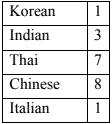| Problem |
Solution |
 1) Restaurants often slip takeout menus under Rudy's
apartment door. Rudy made a chart of how many menus
were from each kind of restaurant. If this data is
representative, then how many of the next 15 menus slipped
under Rudy's apartment door will be Chinese?
1) Restaurants often slip takeout menus under Rudy's
apartment door. Rudy made a chart of how many menus
were from each kind of restaurant. If this data is
representative, then how many of the next 15 menus slipped
under Rudy's apartment door will be Chinese?
|
1. The total number of menus Rudy received was 20.
2. Compute the fraction of the menus that are Chinese = 8/20 = 2/5
3. Apply this fraction to the next 15 menus = 2/5 x 15 =
6 menus.
|
2) The 6th grade classes at Benge Elementary completed a final science test. The average score of the female students is 82 and the average score of the male students is 79. There are 42 girls and 38 boys in the 6th grade. What is the average test score of the entire sixth grade to the nearest whole number? |
1. Multiply the girls' average by the number of girls =
82 x 42 = 3444
2. Multiply the boys' average times the number of boys =
79 x 38 = 3002
3. Add these 2 numbers and divide by the total number of students. =
(3444 + 3002)/(42 + 38) = 6446/80 = 80.575
4. Class average (rounded) is 81
|
3) A target includes 5 concentric circles with diameters of 2, 3, 4, 5, and 6 inches. Assume Jody always hits the target but it is random where on the board the dart hits. What is the probability that she hits the area between the 4 inch and 6 inch diameter circles? Express your answer as a percentage to the nearest tenth. |
1. The target area between the 4 inch and 6 inch diameters are the 6 and 5 inch diameter circles.
2. Compute the area of the 6 in. diameteter circle =
3.14 x 32 = 28.26 sq. in.
3. Subtract the area of the 4 in. diameter circle =
3.14 x 4 = 12.56
4. 28.26 - 12.56 = 15.7 sq. in.
5. The probability = 15.7/28.26 = .5555 rounded = 55.6%
|